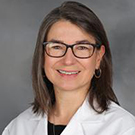Learn from three Stony Brook Medicine experts about HIV/AIDS transmission, testing options, early symptoms, treatments and preventive strategies.
HIV/AIDS treatments have made remarkable strides over the years, transforming what was once a life-threatening diagnosis into a manageable condition. Thanks to advances in medications, people living with HIV can now lead long, healthy lives with proper care. Preventive medications like PrEP (pre-exposure prophylaxis) have also become powerful tools in reducing the spread of the virus.
The Experts
Allison Eliscu, MD, FAAP
Dr. Eliscu is the Division Chief of Adolescent Medicine at Stony Brook Children’s Hospital and cochair the the Stony Brook Medicine LGBTQ* Committee. In this podcast, she discusses the importance of getting tested for HIV and where to get tested, including at a local clinic or your doctor’s office. Testing can be done with a finger prick blood test or a mouth swab, Eliscu explains, and mouth swabs are generally rapid tests with fast results. Eliscu recommends getting tested regularly, especially if you’ve had a recent exposure to HIV, and she discusses the medication PrEP, which can decrease the risk of contracting HIV.
Sarath Nath, MD
Dr. Nath works in adult infectious diseases and runs the Stony Brook Medicine STI Clinic, which is open to adolescents and adults. In this podcast, he explains the difference between HIV and AIDS, and how AIDS is not life-threatening like it used to be many years ago. “People who have AIDS can still have a recovery of the immune system with the amazing medications that we have,” Nath says. Nath also explains how after exposure to HIV, a medication called PEP (post-exposure prophylaxis) can be taken to prevent transmission.
Jennifer Joly, PA
Joly is a physician assistant and HIV specialist who works at the Edie Windsor Healthcare Center in Hampton Bays. In this podcast, she describes the signs and symptoms of an HIV infection, which generally show up about 2-4 weeks after being infected. The symptoms are nonspecific, Joly explains, and may include fever, sore throat, swollen lymph nodes and rash. More severe symptoms occur when the infection progresses into AIDS, she adds.
What You’ll Hear in This Episode
- 00:00: Introductions
- 01:09: General information about HIV/AIDS
- 01:37: The difference between HIV/AIDS
- 02:20: The signs and symptoms of HIV/AIDS
- 03:40: How long can someone live with HIV before knowing they have it?
- 04:15: Getting tested for HIV
- 04:50: Home tests for HIV and when to take them
- 06:50: How is HIV transmitted?
- 09:00: How quickly can HIV be transmitted after being infected?
- 10:30: How to prevent contracting HIV
- 13:20: Is HIV curable?
- 14:10: HIV treatment
- 14:35: Closing remarks
Patient Resources
The Edie Windsor Healthcare Center: The Edie Windsor Healthcare Center specializes in LGBTQ* healthcare services. We provide accessible, compassionate, and comprehensive care to all members and allies of the LGBTQ* community and the treatment and prevention of HIV.
STI Center for Suffolk County: At the Stony Brook STI Center, we offer comprehensive STI (sexually transmitted infection) testing, pre-exposure prophylaxis (PrEP) for preventing HIV infection, and post-exposure prophylaxis (PEP) after exposure to HIV.
LGBTQ* Care at Stony Brook Medicine: We foster community, wellness, and an open and inclusive environment for lesbian, gay, bisexual, transgender, queer (LGBTQ*) patients, faculty, trainees, staff, and the larger community.














